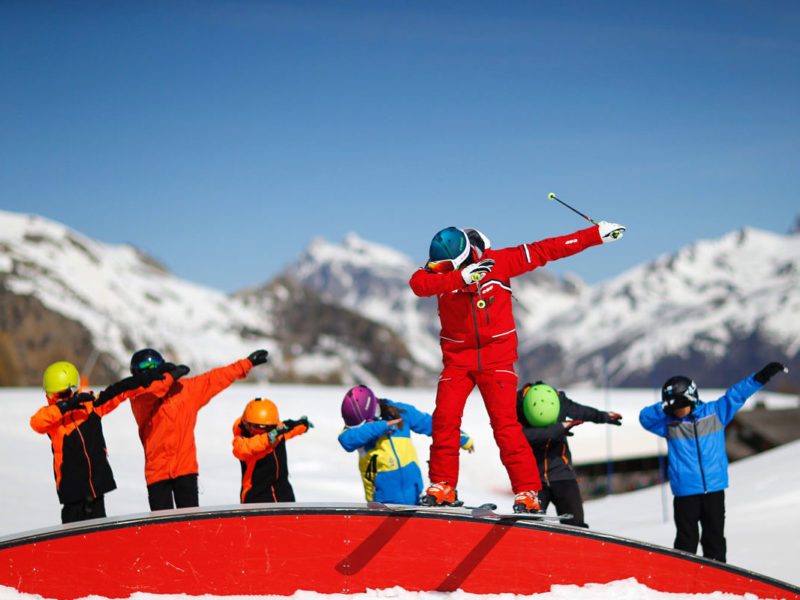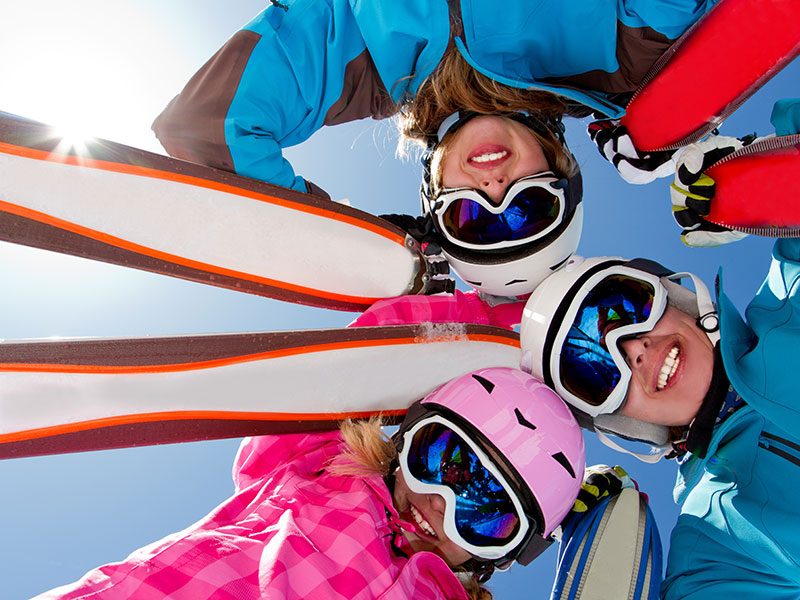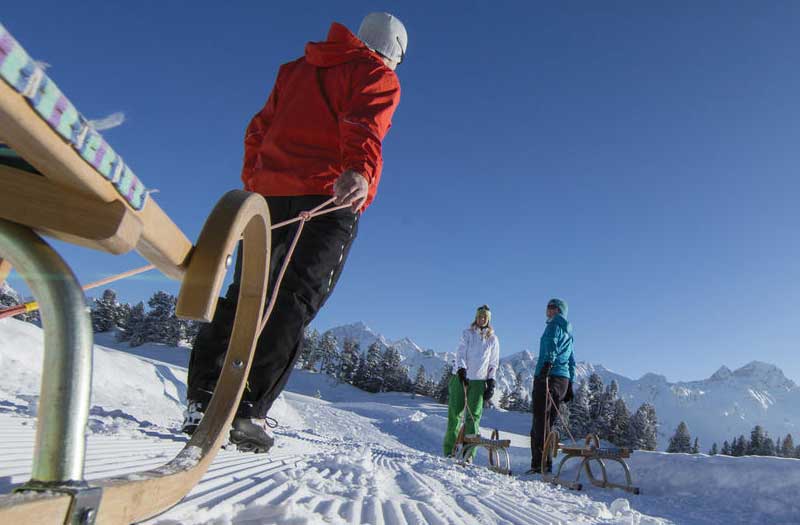Half Term Ski Holiday Guide
Your children work hard at school. They play, study, and learn how relationships and responsibilities work, day in and day out.
Weekends are often filled with football and swimming, get-togethers with friends or extended family, and hours of homework.
In the winter months, they can be stuck inside, staring at the rain on the window, or immersing themselves in a digital world that offers the excitement and activity that they crave.
Sometimes it can seem like life is a constant, revolving schedule, with no end in sight.
But there are events that we look forward to as a family, that float on the horizon and fan our anticipation, bringing a spring to our steps and joy to even the most mundane of activities.
Sometimes a family needs that kind of excitement, and a half term ski holiday is a great way to get it.
Why Ski at Half Term?
All parents know that we either take time off work when the kids are off, or pay for childcare and activities to keep them occupied and looked after while we’re earning a living.
Taking time off to stay at home can be useful sometimes, but it certainly doesn’t result in the same excitement as the anticipation of planning and experiencing a ski holiday to France, Switzerland, or even Sweden!
Anticipating a big trip can keep your children motivated to work hard at school, because the thought of the upcoming event will raise their energy and excitement levels, which will spill over in positive ways to other activities and situations.
Plan as a Family
Don’t just drop a finished package in front of your family and expect them to buy into your idea of the ultimate ski holiday; let the whole family participate.
They’ll be more invested in the process and in the holiday itself, and more committed to making it an enjoyable time for everyone involved.
Activities
Begin by having your first family ski holiday meeting. Have each member of the family list the things they’d like to see or do on the holiday. It might help to have them categorise the items into ‘must-have’ items and ‘nice to have’ items.
You may have to guide this, especially with younger children, by giving suggestions of the kinds of things a resort or neighbouring village might have. You may even want to make a list of the possibilities and have each child select their top five, or top ten, from the list you’ve provided.

Once you’ve all finished, bring the lists together and make a master list. This should also include high priority and lower priority items. Discuss the results, keeping things positive and inclusive, and you’ll soon have an idea of what activities and facilities are very important to your family.
When it comes time to discuss packages and destinations with your travel specialist, you’ll be armed with a clear idea of what your family wants to do, and what they don’t.
Whatever your final list looks like, make sure that there is something exciting on it for each family member. The happier your family is as a whole, the more enjoyment you will get from your time away with them.
As you find out information from the travel specialists, and reservations and confirmations are given, keep the family informed, maybe during further family meetings. This will keep excitement high, which will result in even more fun once you get there.
Equipment and Entertainment
You’ll probably hire any skis, poles, boots, helmets or boards that you need – saves having to haul them on trains or planes anyway – and so there’s no need to plan any of that (though you should let your travel specialist know who is boarding, who is skiing, and the skill levels of each, especially if lessons are part of the plans).
You will, however, be going to a climate that is probably colder than home, and will require some thought.
Make sure you all have adequate coats and thermal underwear. Avoid cotton clothing in general, as it won’t keep you warm at all once it’s wet – and sweating is enough to make it lose any thermal value it might have had. Go for wool, fleece, or any technical fabric made for exercising. If it says that it ‘wicks’ moisture, then it is a good choice.
You should all have winter hats and gloves or mittens. Mittens will keep hands warmer, but inhibit doing up buckles and laces, so though they’re great for the little ones, older children will probably prefer gloves and put up with some chilled fingers.

Also don’t forget that people need down time, and though you won’t want them online the whole time, it is fun to post pictures and send messages, especially as a family, to highlight the fun you’re having on your trip… so allow some social media time, and even some time to watch a film in the evening, or a favourite program or two.
Not too much, but a little won’t hurt, and will help your kids to feel engaged with their usual world and comforting habits in the midst of so many new experiences.
It is also very important to include comfortable shoes and/or slippers in your bags. This allows you and your children to give feet and ankles a rest from the confines of ski and boarding boots. Something suitable for walking around town, too, is important.
Remember, skiing is the theme, and perhaps the main activity, but there is a lot more going on, and you’ll need proper clothing to take part in whatever activities – expected and otherwise – you and your family may encounter once there.
Half Term Dates – 2019
Schools vary a little, but term breaks are around the same time of year for most of them.
Autumn Half Term
Autumn half term falls within the second half of October, which is a little early for most resorts to have adequate snow for skiing.
Your travel specialist may be able to help you find a resort that suits your needs and is open that early, but you’ll be very limited in your choices.
A high-altitude resort like Zermatt could be an option, but make sure you talk it over with your travel specialist before booking any time off work.
Spring Half Term
Spring half term falls in the second half of February, and that’s good news for skiers. It means that you can take your family to the resort during some of the most popular weeks of the year.
It may be more crowded, but with good reason: the snow is still plentiful, and the weather is generally warmer, with longer, sunny days and that overall feeling of the coming spring.
The break is usually nine days long – a full work week with a weekend tacked onto either end – and provides more than enough time for travel, skiing, and recuperation afterwards.

Because it falls later in the school year, the anticipation of it also lasts longer, allowing your children to look forward to it even on days when the routine of school is low on their list of favourite things. An added bonus is that you can give the trip to your family as a Christmas present, and the excitement of it will last for months.
A word of caution though, don’t use the trip as a reward for certain academic achievements, like certain grades or scores on examinations. If one or more of your children fails to reach the goal, you’ll have a prepaid trip on your hands and a parenting dilemma… best to steer clear of such complications.
Recommended Half-Term Ski Resorts
This brief overview should give you an idea of the kind of things to consider when choosing a resort to visit. If there is something you like about one resort, and another thing about another resort, share that with your travel specialist.
Tignes (France)
Tignes is nestled in the Savoie region of the French Alps, amid stunning mountains and rock formations that make up scenery that in itself is worth the trip.
Tignes has 300km of marked runs, most of them groomed, which provide everything from easy fun for beginners to challenges for even the expert skier in your family. The area includes 78 ski lifts, which spreads out the crowds and keeps queues manageable, even during popular ski times. Tignes usually has good snow from October through to April, due to its high elevation.
The community around Tignes varies a lot. There are areas that are very lively, and fond of parties and celebrations, but there are also quaint little areas where you and your family can experience a quieter holiday experience. Stay in a quiet area and you can always make short excursions into more active areas when you want to.
The area has all of the usual off-resort options for fun and relaxation. The adults might want to step out to a local bar or nightclub while little ones sleep under the care of a nanny or older sibling. The family might want to catch a film, visit the Tignes Multimedia Centre, go swimming or see what’s offered at the wellness centres. There are often concerts of various kinds too.
Tignes is an excellent choice if your family is a bit older, teens and tweens especially, but also offers some activities for the younger ones too. If your family has a wide spread of ages, from little ones to near-adult children, this might be the wide-ranging fit you’re looking for.
Learn more about ski holidays in Tignes
Val Thorens (France)
Val Thorens is also in the Savoie region of the French Alps, and boasts many of the same stunning views and majestic scenery. It is the highest resort in Europe, at 2300m, and has some of the most reliable snow conditions. Though it was once thought too high to construct a viable resort, it is now one of the most successful destinations in the Alps.
Make sure you have proper gear for colder days, as the high elevation can mean lower temperatures, even when the sun is shining and the day clear. The resort faces south, so it catches direct sunlight throughout the day, but the slopes are mostly in the shadow of the mountains, which means a deeper cold should be expected once you start skiing. The activity should keep you warm though, and the cold air will help to keep snow conditions excellent throughout your stay.
There will be no lack of choice when it comes to skiing Val Thorens, as it is linked to the rest of the Trois Vallées ski area, putting over 600km of piste right in front of you.
This combination makes Val Thorens part of one of the largest ski areas in the world.
Livigno (Italy)
Livigno is located in the Italian Alps, just north of the Swiss border. It’s a high-altitude resort, so good snow conditions are to be expected, especially in February. The resort is reasonably-priced, but is smaller than many of its more popular competitors, and does not have as many of the more dramatic, expert runs that other places boast of and highlight on their brochures – though it does have a few.
If you and your family members are beginners though, or intermediate skiers with no aspirations to tackle expert runs, then Livigno will suit your preferences very well. It is a popular choice for younger families, whose members are less likely to need a wide range of expert runs to choose from.
The lifts at Livigno are very modern and easy to use – great for younger skiers and beginners, and the pass for the Alta Valtellina area also includes access to Bormio and Santa Caterina lifts. There is a free bus service to each, with rides ranging from an hour to Bormio, to an hour and a half to Santa Caterina. You’ll also get a half-price deal offer for one day in St Moritz, also about an hour and a half by bus.
The surrounding village is busy, friendly, and pretty, with an Alpine feel about it that will really immerse you in landscape and feel of the area.
Zermatt (Switzerland)
Zermatt isn’t the highest resort in Europe, but it is the highest in Switzerland. Snow should be in good supply for either an October or February trip – it is even open for skiing all summer!
Though Zermatt is known for having great moguls, there is a wide variety of slopes to keep all members of the family happy. There are four main skiing areas at Zermatt itself, and it also has a connection to a couple of Italian resorts, via the Plateau Rosa glacier. Whether you stay around Zermatt, or venture across to the Italian side, you will have everything you need to keep busy and entertained for your stay. This resort has all of the fun, events, and facilities you and your family might need.
Adding to the charm of the area is the car-free town, so you can stroll through it immersed in safe, friendly foot-traffic, sampling the restaurants, cafés, cinemas and other attractions. Leave the hustle and bustle of work and school behind for a few days; walk the streets and ski the slopes of Zermatt.
Riksgransen (Sweden)
Riksgransen, in the Swedish Lapland, is the most northerly resort in Europe. Its lower altitude would be a problem in more southerly regions, but because of its location, it retains good snow cover most of the year.
In fact, the village had to be evacuated a hundred years ago because there was too much snow to get on with daily life! That old burden has now become of great value to the community, as the snow conditions are reliable even late into the season, and the reliability of conditions attracts skiers from all over the world.
Another great feature for families is that the village is only about 200m from the resort, so it is easy to venture on foot to explore shops, restaurants, and entertainment. It is a safe area, even at night, and you’ll have the added bonus of beautiful northern lights flashing through the night sky.
Åre (Sweden)
A little farther south, but still in Sweden, is Åre (pronounced like ‘aura’). The recent addition of direct flights into western Sweden means that this resort is easily reachable from the UK, which has not always been the case.
Åre has more than a thousand acres of terrain, which spreads out its users over a wide territory. The result is that you spend more of your time on the slopes, and less of it in queues. More space is better for beginners too. It gives skiers of all sizes the room needed to practice skills without having to worry about high-density ski traffic. This helps them to get comfortable and confident on the snow – which is what every parent wants for their children on a ski holiday.
The lakeside town has all the restaurants, lounges, and entertainment you’ll want, including live music and zip wires and even its very own chocolate factory.
If you have one or more children under the age of seven, you get an added bonus at Åre – they get to ski for free!
Summary
We work hard; we should get to play hard too.
Few things beat the refreshing fun of a ski getaway with the family, especially in the midst of the long winter rains and daily burden of homework and livelihood.
Take your loved ones out of it all; give them a week on the top of the world, skis on their feet and joy in their hearts as they learn to ski – or improve their skills – in the midst of beautiful scenery and quality family time. Half-term breaks are an ideal window for winter fun.



